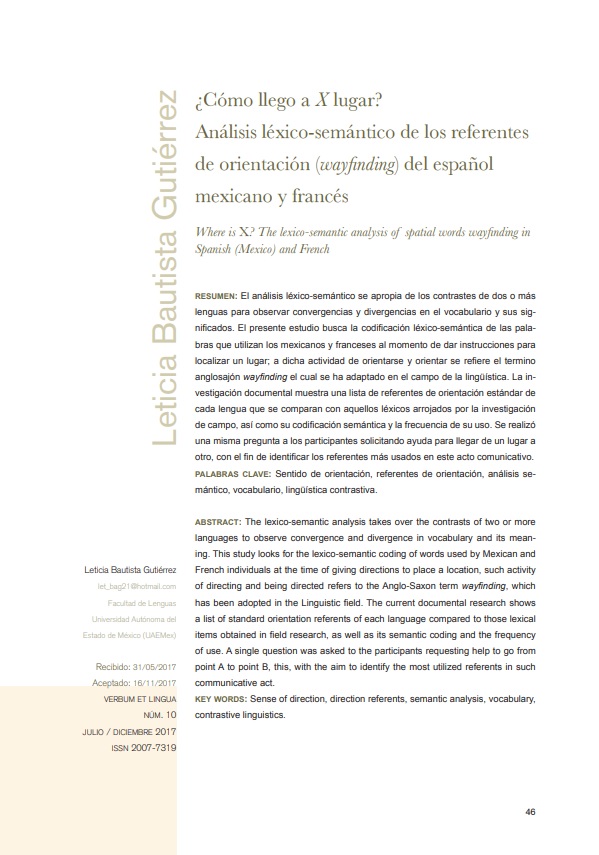¿Cómo llego a X lugar? Análisis léxico-semántico de los referentes de orientación (wayfinding) del español mexicano y francés
DOI:
https://doi.org/10.32870/vel.vi10.94Parole chiave:
Sentido de orientación, referentes de orientación, análisis semántico, vocabulario, lingüística contrastivaAbstract
El análisis léxico-semántico se apropia de los contrastes de dos o más lenguas para observar convergencias y divergencias en el vocabulario y sus significados. El presente estudio busca la codificación léxico-semántica de las palabras que utilizan los mexicanos y franceses al momento de dar instrucciones para localizar un lugar; a dicha actividad de orientarse y orientar se refiere el termino anglosajón wayfinding el cual se ha adaptado en el campo de la lingüística. La investigación documental muestra una lista de referentes de orientación estándar de cada lengua que se comparan con aquellos léxicos arrojados por la investigación de campo, así como su codificación semántica y la frecuencia de su uso. Se realizó una misma pregunta a los participantes solicitando ayuda para llegar de un lugar a otro, con el fin de identificar los referentes más usados en este acto comunicativo.
Downloads
Metriche
Riferimenti bibliografici
Aragones, J. I. (1983). Marcos de referencia en el estudio de los mapas cognitivos de ambientes urbanos. Estudios de Psicología (14-15), 35-46.
Ávila Cañamares, I. (2015). Percepción y pensamiento espacial. La veta reduccionista del enfoque enactivo. Ideas y Valores, 64 (157), 191-214.
Colledge R. G. (1999). Wayfinding behaviour: Cognitive mapping and other spatial processes. ee.uu.: The Johns Hopkins University.
Ewald, J. D. (2010). ‘‘Do you know where X is?’’: Direction-giving and male/female direction givers. Journal of Pragmatics, 42 (9), 2549-2561.
García, D. (2012). Diseño de sistemas de orientación espacial: Wayfinding. Madrid: Laboratorio Wayfinding.
Hund, A. M., Schmettowb, M. & Noordzij, M. L. (2012). The impact of culture and recipient perspective on direction giving in the service of wayfinding. Journal of Environmental Psychology, 32 (4), 327-336.
Hund, A. M. & Nazarczuk, S. N. (2008). The effects of sense of direction and training experience on wayfinding efficiency. Journal of Environmental Psychology, 29 (1), 151-159.
Hund, A. M. & Padgitt, A. J. (2010). Direction giving and following in the service of wayfinding in a complex indoor environment. Journal of Environmental Psychology, 30 (4), 553-564.
Lynch, K. (2008). La imagen de la ciudad. España: Gustavo Gilli. (Trabajo original publicado en 1960).
MacFadden, A., Lorin, E. & Saucier, D. (2003). Males and females scan maps similarly, but give directions differently. Brain and Cognition, 53 (2), 297-300.
Marchesi, A. (1983). Conceptos espaciales, mapas cognitivos y orientación en el espacio. Studies in Psychology, 4 (14-15), 85-92.
Padgitt A. J. & Hund, A. M. (2012). How good are these directions? Determining direction quality and wayfinding efficiency. Journal of Environmental Psychology, 32 (2), 164-172.













